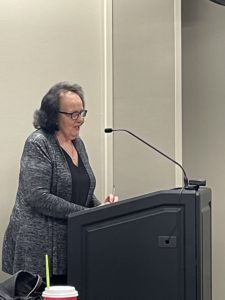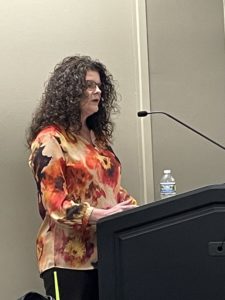
By Frank Phillips
DLC Media News
Photos: (Top) Bryan Strain and Chris Mauk listen to part of a presentation on vaping in Clay Community Schools.
(Middle) Kathy Knust introduces the dangers of vaping to the Clay Community Schools Board of Trustees on Thursday.
(Bottom) Andrea Dawes speak to the school board.
Brazil – Vaping is becoming a very large problem in Clay Community Schools, the corporation’s Kathy Knust told the school board of trustees Thursday night.
“Vape detectors were installed in all secondary schools during the second semester of the 2021-2022 school year in an effort to help address what we feared was an increase in the number of students vaping on school property during the school year,” Knust said.

However, school officials were not prepared for the dramatic increase in vaping among students.
Northview High School Principal Chris Mauk said the detectors revealed “this was an issue that was getting out of hand.”
Some students would inhale the vapors containing nicotine and even THC (marijuana) during class when teachers’ backs were turned. Others, would find places without the vape detectors, such as the media center to inhale.
Northview is associated with the Western Indiana Conference. In addition to athletic events, the conference serves to improve academics as well. But, when the issue of vaping was discussed, all of the members of the WIC agreed it is a growing problem, but no one had an answer.
“Our number one concern is the health and safety of our students,” Mauk said. “Our current disciplinary measures are not changing their behaviors.”
Northview Assistant Principal Bryan Strain gave samples of the three kinds of vaping products found in Northview. The products range from nicotine to THC (marijuana).
Discipline varies up to and including 10 days of suspension and a recommendation for expulsion.
Last year, school officials received 67 referrals of students who were caught vaping. There have been 39 referrals so far this year, indicating there will be an increase during the school year.
During a question time, it was pointed out that some students are referred for vaping more than once.

Andrea Dawes, a therapeutic counselor at Cumberland Academy, said students are almost never caught using tobacco products. But vaping is a gateway to using tobacco when students cannot obtain vaping supplies.
One pod containing the chemical used for vaping contains as much nicotine as 20 to 60 cigarettes, she said of one form of vaping that contains nicotine.
Years ago, there was a social stigma associated with use of tobacco among high school students. That is not the case with vaping, Mauk said.
“It cuts across all groups,” Mauk said. “Students feel vaping is harmless” even though it leads to medical issues and some students have had to be taken from school to the hospital after vaping.
“This evening, we are asking for board support and approval to allow us to pilot the American Heart Association INDEPTH program in place of (the school corporation’s) current Tobacco Education Group program and study additional vaping education options for the remainder of the school year.
That request was approved unanimously by the board members.
Knust said the committee that is studying the problem will return to the school board with a comprehensive plan prior to the beginning of the 2023-2024 school year.
In making his motion to give that committee permission to go ahead, Trustee Dr. Michael Shaw said, “I believe education is much more important than punishment in this matter.”
Board President Tom Reberger said his study has shown vaping products are not regulated.

